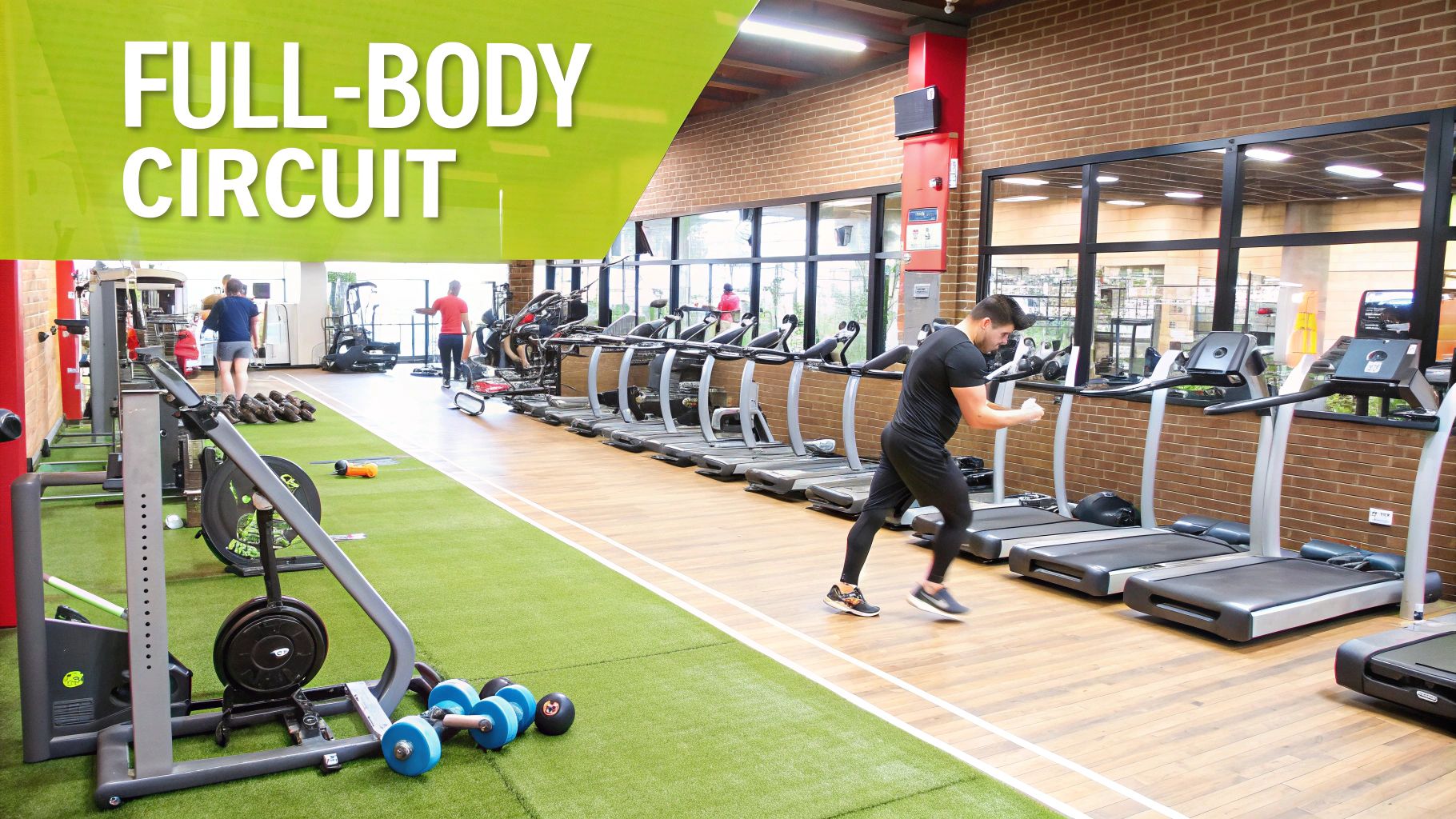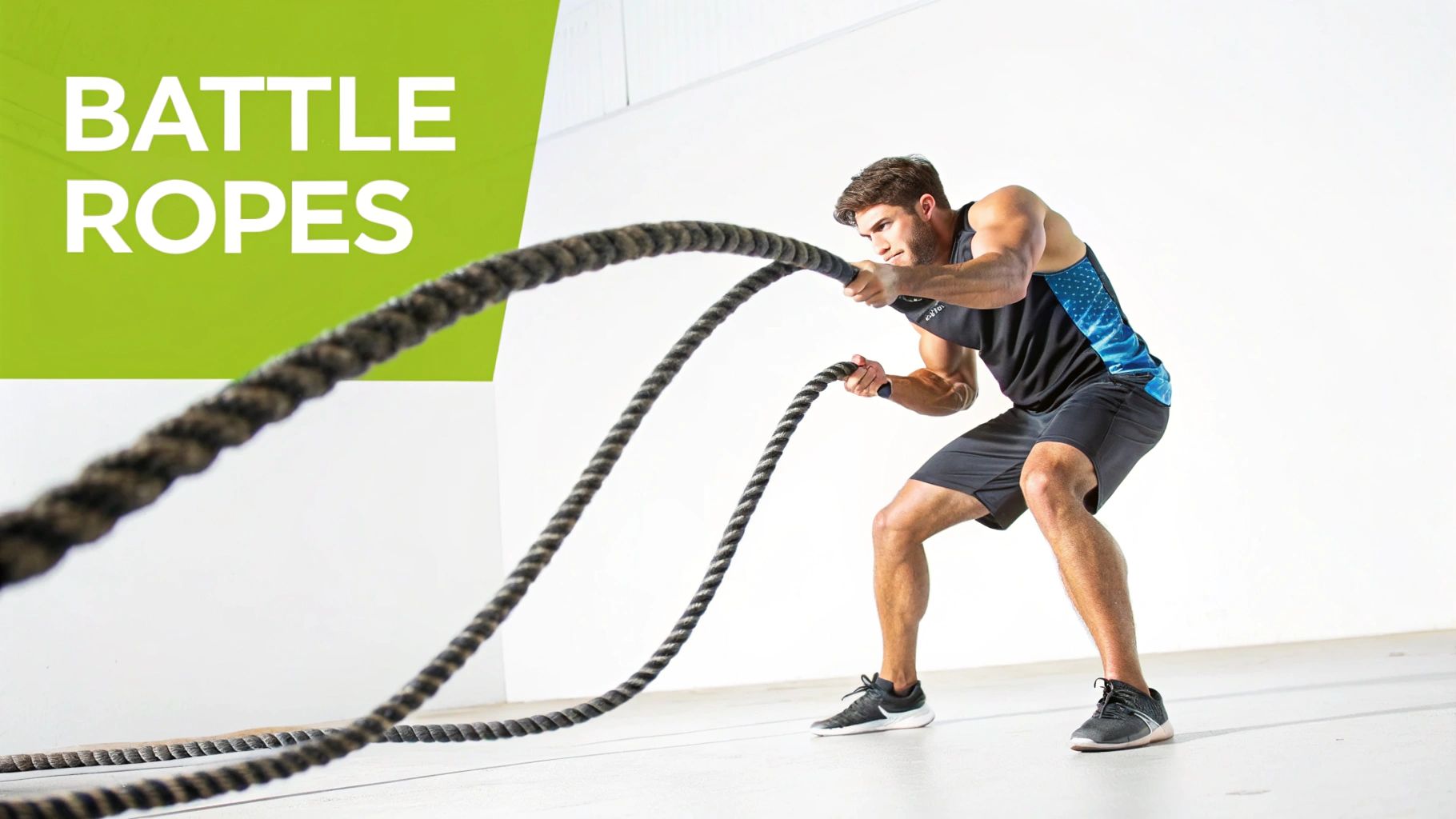In the heat of a gruelling padel match, when technique falters and fatigue sets in, one attribute consistently separates the winners from the rest: stamina. It’s the engine that powers your game, allowing you to maintain explosive movements, sharp decision-making, and consistent shot quality from the first serve to the final point. While skill and strategy are crucial, they become ineffective if you’re too exhausted to execute them properly in the third set. Superior endurance means you can outlast your opponents, forcing them into errors as their own energy levels decline. This is where dedicated stamina training exercises become your most valuable asset off the court.
This guide moves beyond generic advice to provide a curated list of eight powerful training methods designed to elevate your physical performance. We will break down specific workouts like High-Intensity Interval Training (HIIT), Fartlek runs, and battle rope drills, explaining how each one translates directly to the demands of padel. You will learn not just what to do, but how to integrate these exercises into your routine for maximum impact. To delve deeper into the overarching principles and techniques for building endurance, consider exploring a comprehensive guide on how to improve stamina. Let’s get started.
1. High-Intensity Interval Training (HIIT)
High-Intensity Interval Training, or HIIT, is a cornerstone of effective stamina training exercises. It revolves around a simple yet powerful principle: alternating between short, explosive bursts of all-out effort and brief periods of active recovery or complete rest. This method pushes your cardiovascular system to its limits, significantly improving your VO2 max (the maximum amount of oxygen your body can use during exercise) and anaerobic threshold.
For padel players, this translates directly to on-court performance. Think of those relentless, high-paced rallies where you need to sprint, lunge, and smash in quick succession. HIIT mimics this stop-start nature perfectly, training your body to recover faster between points and maintain explosive power deep into the third set. It’s the ultimate tool for building the resilience needed to outlast your opponents.

Buy the best padel gear to level up your next game!
CHECK OUT this deal from Padel Market!Get ready to take your game to the next level with the latest padel gear from Padel Market! Fast EU and Worldwide Shipping
How to Implement HIIT for Padel
Integrating HIIT is straightforward. You can use bodyweight exercises, running sprints, or even on-court drills. A classic example is the Tabata protocol: 20 seconds of maximum effort (like burpees or high knees) followed by 10 seconds of rest, repeated for eight rounds (four minutes total).
Another effective structure involves sprint intervals:
- Warm-up: 5-10 minutes of light jogging and dynamic stretches.
- Work Interval: 30 seconds of all-out sprinting.
- Recovery Interval: 90 seconds of walking or slow jogging.
- Rounds: Repeat this cycle 6-8 times.
- Cool-down: 5 minutes of stretching.
The following infographic provides a quick reference for the core metrics of a typical HIIT session.
As the data shows, HIIT is incredibly time-efficient, delivering significant cardiovascular benefits in sessions as short as 15 minutes by focusing on maximum intensity. This makes it an ideal training method for busy players wanting to boost their stamina without spending hours in the gym, complementing the skills learned from resources like how to play padel. Always prioritise proper form to prevent injury, especially as fatigue sets in.
2. Long Slow Distance (LSD) Running
In stark contrast to the explosive nature of HIIT, Long Slow Distance (LSD) running is a foundational component of any comprehensive stamina training plan. Popularised by legendary coach Arthur Lydiard, this method involves running at a steady, conversational pace for an extended duration, typically 60 minutes or more. The goal isn’t speed, but time on your feet, which builds a robust aerobic base, strengthens your heart, and trains your body to become more efficient at using fat for fuel.
For a padel player, a strong aerobic base is the engine that powers your entire game. While HIIT prepares you for short, intense bursts, LSD running gives you the underlying endurance to stay fresh through long matches and gruelling three-setters. It builds the resilience needed to recover between points and maintain a high level of performance from the first serve to the final point, preventing that late-match fatigue that often leads to unforced errors.

How to Implement LSD Running for Padel
Integrating LSD into your routine is about consistency and patience. The key is to keep the intensity low enough that you could hold a conversation without gasping for breath. This is often referred to as Zone 2 training, where your heart rate remains in a low to moderate range.
Here’s how to get started with this stamina training exercise:
- Start Small: Begin with a 45-60 minute run at a very comfortable pace. Don’t worry about distance, focus on duration.
- Progress Gradually: Increase your weekly long run duration by no more than 10% each week to avoid injury.
- Pace Yourself: The effort should feel easy. If you have a heart rate monitor, aim for 60-70% of your maximum heart rate.
- Fuel and Hydrate: Use these long runs as an opportunity to practise your on-court nutrition and hydration strategies.
- Listen to Your Body: If you feel overly fatigued, don’t be afraid to incorporate walk breaks. The aim is to stay in the aerobic zone, not to push your limits.
This method is less about immediate, explosive power and more about building the deep, unshakable endurance that allows you to outlast and outwork your opponents. It is the perfect complement to the high-intensity work you do on the court and in other training sessions.
3. Circuit Training
Circuit training is a highly effective method for developing comprehensive fitness, blending strength exercises and cardiovascular work into a single, fast-paced session. It involves moving sequentially through a series of exercise stations, performing each for a set time with minimal rest in between. This approach keeps your heart rate elevated, powerfully boosting both your muscular endurance and cardiovascular stamina simultaneously.

For padel players, this training style is invaluable. A match demands repeated explosive movements, sustained rallies, and the ability to maintain strength even when fatigued. Circuit training replicates this environment by forcing your body to switch between different physical demands under pressure. It builds the resilience needed to execute a powerful bandeja in the first game and a precise volley in the last, ensuring your performance remains consistent throughout the entire match.
How to Implement Circuit Training for Padel
A padel-focused circuit should combine movements that mimic on-court actions with general conditioning exercises. The goal is to create a well-rounded workout that improves your overall athletic base. You can perform these circuits at a gym, at home, or even at an outdoor park.
Here is a sample padel circuit structure:
- Warm-up: 5-10 minutes of light cardio and dynamic stretching.
- Circuit: Perform each exercise for 45 seconds, followed by 15 seconds of rest/transition to the next station.
- Station 1: Kettlebell Swings (for explosive hip power)
- Station 2: Box Jumps (for vertical power)
- Station 3: Medicine Ball Slams (for core and upper body strength)
- Station 4: Lateral Lunges (for side-to-side agility)
- Station 5: Plank (for core stability)
- Station 6: Skipping Rope (for footwork and cardio)
- Rest: After completing all stations, rest for 2-3 minutes.
- Rounds: Repeat the entire circuit 3-4 times.
- Cool-down: 5 minutes of static stretching.
By incorporating dynamic movements, this type of circuit not only builds stamina but also sharpens your agility and coordination, complementing specific drills like these exercises for reaction time. Always focus on maintaining good form, especially as you get tired, to maximise benefits and minimise injury risk.

Buy the best padel gear to level up your next game!
CHECK OUT this deal from Padel Market!Get ready to take your game to the next level with the latest padel gear from Padel Market! Fast EU and Worldwide Shipping
4. Fartlek Training
Fartlek, a Swedish term meaning ‘speed play’, is one of the most flexible and intuitive stamina training exercises available. It’s an unstructured form of interval training where you vary your pace throughout a continuous run based on how you feel, rather than adhering to rigid, predetermined timings. This method brilliantly merges steady-state cardio with random bursts of higher intensity, enhancing both your aerobic base and your ability to surge when needed.
For padel players, Fartlek training is exceptionally relevant. The unpredictable nature of a padel match, with its sudden sprints to the net, quick lateral movements, and longer, grinding rallies, is perfectly simulated by this ‘speed play’ approach. It trains your body to handle fluctuating demands on your energy systems, helping you maintain a high level of performance and recover swiftly from intense exchanges without a rigid structure.
How to Implement Fartlek Training for Padel
The beauty of Fartlek is its simplicity and reliance on instinct over a stopwatch. You can perform it anywhere, using natural surroundings as your guide. The goal is to mix different paces into a single, continuous run.
A typical Fartlek session could look like this:
- Warm-up: 5-10 minutes of light jogging to prepare your muscles.
- Speed Play: Begin your run and vary your pace using landmarks. For example:
- Jog at a comfortable pace.
- Sprint hard to the next lamp post or a specific tree.
- Recover with a slow jog until you reach a park bench.
- Run at a tempo pace (comfortably hard) up the next hill.
- Walk or jog slowly down the hill to recover.
- Duration: Continue this pattern of surges and recoveries for 20-30 minutes.
- Cool-down: Finish with 5-10 minutes of walking and static stretching.
The key is to listen to your body and play with speed. Some days you might feel energetic and include more sprints, while other days might involve longer, steadier efforts. This adaptability makes Fartlek a sustainable and enjoyable method for building the robust stamina needed to dominate the padel court.
5. Rowing Machine Workouts
Rowing machine workouts are a formidable tool in the arsenal of stamina training exercises, offering a full-body, low-impact cardiovascular challenge. This type of training engages around 86% of your body’s muscles, including your legs, core, back, and arms, in a fluid, coordinated movement. The result is a significant improvement in both muscular endurance and cardiovascular capacity, all while being gentle on your joints.
For padel players, this comprehensive engagement is invaluable. The powerful leg drive in rowing mirrors the explosive movements needed to push off for a smash or lunge for a wide ball. A strong, engaged core developed through rowing is crucial for rotational power and stability during volleys and bandejas. This makes rowing an exceptionally efficient way to build the all-over resilience required to maintain a high level of play throughout a gruelling match.
How to Implement Rowing for Padel
To get started, focus on mastering the correct technique before ramping up the intensity. The rowing stroke follows a specific sequence: legs, core, then arms on the drive, and arms, core, then legs on the recovery. Maintaining a 2:1 ratio of recovery time to drive time is key for sustainable effort.
Here are some effective rowing workouts to build your stamina:
- Warm-up: 5-10 minutes of light rowing with mobility drills, focusing on opening the hips and thoracic spine.
- Steady-State: Row for 30-45 minutes at a comfortable, consistent pace, keeping your stroke rate between 18-24 strokes per minute.
- Intervals: Perform 8 rounds of a 250-metre sprint followed by 90 seconds of light rowing or complete rest.
- Benchmark: Test your progress with a 2000-metre time trial every 4-6 weeks.
- Cool-down: 5 minutes of easy rowing followed by static stretching.
By incorporating rowing into your routine, you are not just doing another cardio exercise; you are building a stronger, more powerful and resilient athletic base. This focus on combined strength and endurance makes it one of the most effective stamina training exercises available, directly enhancing your ability to perform with consistent power and agility on the padel court.
6. Battle Ropes
Battle rope training is one of the most dynamic and effective stamina training exercises available, offering a full-body workout that builds both cardiovascular endurance and muscular strength. It involves creating continuous movements like waves, slams, and spirals with heavy ropes, engaging your heart, lungs, and muscles simultaneously. This form of training is a powerful tool for developing work capacity and raw power.

For padel players, the benefits are immense. The constant, explosive arm and shoulder movements directly mimic the power needed for smashes and bandejas, while the core engagement required to stay stable builds rotational strength. Furthermore, the intense cardiovascular demand trains your body to sustain high-effort outputs for longer periods, helping you maintain peak performance during taxing, extended rallies. It also drastically improves grip strength, a crucial but often overlooked aspect of racket control.
How to Implement Battle Ropes for Padel
Battle ropes are highly adaptable and can be integrated into your routine as a standalone session or as part of a larger circuit. Focus on short, intense bursts of work followed by brief recovery periods to maximise stamina gains. Start with basic movements before progressing to more complex variations.
Here are a few ways to structure your training:
- Alternating Waves: Perform alternating waves for 30 seconds, followed by 30 seconds of rest. Repeat for 5-8 rounds.
- Tabata Protocol: Choose an exercise like double waves or slams. Work at maximum effort for 20 seconds, rest for 10 seconds, and repeat for eight rounds (four minutes).
- Power Slams: Execute powerful two-handed slams for 15 seconds, rest for 45 seconds, and repeat 6-10 times to build explosive power.
As demonstrated, maintaining a solid athletic stance with a hinged hip and engaged core is fundamental to generating power and preventing injury. Always prioritise creating consistent, powerful waves rather than just flailing the ropes. As your endurance improves, you can increase the work intervals or decrease rest times to continue challenging your stamina.
7. Swimming Intervals
Swimming interval training is a powerful, low-impact method for enhancing your stamina. It involves alternating between swimming at high intensities and periods of rest or slower-paced recovery. This type of training is exceptional for developing cardiovascular fitness and muscular endurance across the entire body, all while placing zero impact on your joints, making it a sustainable addition to any high-impact sport regimen.
For padel players, the benefits are two-fold. Firstly, it builds phenomenal lung capacity and aerobic power, crucial for maintaining energy through long matches. Secondly, the water’s resistance strengthens your core, back, shoulders, and legs simultaneously, which contributes to more powerful smashes and greater stability during quick lateral movements. It’s an ideal cross-training exercise that builds resilience without the wear and tear of running on hard surfaces.
How to Implement Swimming Intervals for Padel
To start, you need access to a pool and a basic understanding of freestyle or your preferred stroke. The key is to structure your session around work and rest intervals, using a pace clock or waterproof watch to stay on track.
Here are a few classic swimming interval sets:
- Warm-up: 5-10 minutes of easy swimming and light drills.
- Main Set (Option 1): 10 repetitions of 100 metres freestyle, starting a new one every 2 minutes and 30 seconds. The rest is the time you have left before the next interval begins.
- Main Set (Option 2): 8 repetitions of 50 metres at a fast pace, with 45 seconds of rest after each one.
- Cool-down: 5 minutes of slow, relaxed swimming.
Focusing on efficient technique is paramount; good form allows you to swim longer and faster with less effort, which is the very essence of stamina. Varying your strokes and incorporating kick-only or pull-only sets (using a kickboard or pull buoy) can help target specific muscle groups and prevent boredom. This approach to stamina training exercises ensures you build a robust aerobic engine that will keep you energised from the first serve to the final match point.
8. Stair Climbing/Stadium Steps
Stair climbing is a classic yet incredibly effective form of stamina training exercise, popularised in countless training montages for a reason. It involves repeatedly ascending stairs or stadium steps to build explosive lower body power, cardiovascular endurance, and sheer mental grit. This functional workout combines strength and cardio, directly strengthening the quads, glutes, and calves while pushing your heart rate sky-high.
For padel players, this translates into powerful and resilient legs. The upward driving motion mimics the explosive movements needed for a powerful smash or a quick lunge to the net. Building this type of endurance means you can maintain that explosive first step and stay light on your feet, even when a match goes the distance. It’s a low-cost, high-impact method for forging lower-body stamina.
How to Implement Stair Climbing for Padel
You can easily adapt stair climbing to your fitness level, using a local stadium, an office building stairwell, or even a stair machine at the gym. The key is progressive overload and consistency. Start with a manageable volume and gradually increase the duration or intensity.
Here are a few effective protocols:
- Warm-up: 5-10 minutes of light jogging and dynamic stretches.
- Workout Option 1 (Endurance): Climb continuously at a steady, challenging pace for 20-30 minutes.
- Workout Option 2 (Power): Sprint up a flight of stairs (or 20-30 steps), then walk back down slowly to recover. Repeat this 8-12 times.
- Workout Option 3 (Strength): Ascend by taking two steps at a time, focusing on powerful leg drive. Walk back down. Repeat for 10-15 minutes.
- Cool-down: 5 minutes of static stretching, focusing on your quads, hamstrings, and calves.
To maximise safety and performance, descend carefully to reduce impact on your knees and focus on a quick, light turnover on the way up. Wearing the right footwear is also critical for this high-impact activity; you can find the best padel shoes that offer the necessary support and traction for this type of cross-training. Prioritising good form and proper gear will help you build stamina safely.
Stamina Training Exercises Comparison Matrix
| Training Method | Implementation Complexity 🔄 | Resource Requirements ⚡ | Expected Outcomes 📊 | Ideal Use Cases 💡 | Key Advantages ⭐ |
|---|---|---|---|---|---|
| High-Intensity Interval Training (HIIT) | Moderate (structured intervals with rest) | Minimal equipment, short sessions | Improved aerobic & anaerobic capacity, fat burn | Time-efficient fitness, cardiovascular & metabolic gains | Quick results, EPOC effect, varied exercises |
| Long Slow Distance (LSD) Running | Low (steady, long duration runs) | No equipment beyond shoes, time commitment | Strong aerobic base, fat oxidation, endurance | Base endurance building, beginners, frequent training | Low injury risk, mental toughness, fat metabolism |
| Circuit Training | Moderate to High (multiple stations, minimal rest) | Multiple equipment or space needed | Balanced cardiovascular and strength improvements | Full-body conditioning, varied training sessions | Versatile, efficient, functional movement |
| Fartlek Training | Low (unstructured pace variation) | None needed, outdoor/free environment | Aerobic and anaerobic improvements, pacing skills | Enjoyable speed play, adaptive training | Fun, intuitive, terrain adaptable |
| Rowing Machine Workouts | Moderate (technical skill required) | Rowing machine needed | Full-body conditioning, cardiovascular & muscular endurance | Indoor training, low-impact full-body workout | Measurable progress, low joint stress |
| Battle Ropes | Moderate (specific movements and intervals) | Requires space, anchor point, battle ropes | Functional strength, power, grip, cardiovascular | High-intensity workouts, functional fitness | Explosive power, scalable intensity |
| Swimming Intervals | Moderate (structured intervals, technique focus) | Pool access and swimming equipment | Cardiovascular fitness, muscular endurance, lung capacity | Non-impact fitness, rehab, full-body conditioning | Zero joint impact, all ages/levels, technique |
| Stair Climbing/Stadium Steps | Low to Moderate (simple but high impact) | Access to stairs or stadium steps | Lower body power, cardio endurance, mental toughness | Functional leg strength, urban/outdoor workouts | Practical, intense calorie burn |
Integrating Your New Stamina Routine for Peak Padel Performance
You now have a powerful arsenal of stamina training exercises designed to transform your performance on the padel court. We’ve moved beyond generic advice, exploring the distinct benefits of everything from the explosive power of HIIT and battle ropes to the foundational endurance built through LSD running and swimming. The key takeaway is not just knowing what these exercises are, but understanding how to weave them into a coherent and personalised training plan. Padel is a game of relentless, explosive movements, and your stamina must be versatile enough to handle both the lung-busting sprints and the long, grinding rallies of a third-set tie-breaker.
The exercises detailed in this guide, including circuit training, Fartlek, and stair climbing, are all tools in your toolbox. The true mastery lies in intelligently combining them. Your goal is to build a robust cardiovascular system that can recover quickly between points, maintain mental sharpness under physical duress, and consistently outlast your opponents.
From Knowledge to Action: Your Next Steps
To truly benefit from these insights, you must transition from reading to doing. Here is a practical roadmap to get you started:
- Assess Your Baseline: Before you begin, honestly evaluate your current fitness. Can you comfortably run for 30 minutes? Do you feel winded after a few fast-paced points? Use this as your starting point to select the right exercises.
- Create a Balanced Schedule: Don’t just do HIIT every day. A smart weekly plan might include two HIIT or Fartlek sessions, one LSD run for aerobic base-building, and one circuit training session focused on padel-specific movements. This variety prevents burnout and targets different energy systems.
- Prioritise Consistency Over Intensity: Showing up consistently is more important than a single, heroic workout that leaves you sore for a week. Start with shorter durations and lower intensity, gradually increasing the challenge as your body adapts. Remember, progress in stamina training is a marathon, not a sprint.
- Listen to Your Body and Fuel It Properly: Overtraining is the fastest way to derail your progress. Pay attention to signs of fatigue, muscle soreness, and a lack of motivation. Recovery is where your body rebuilds and gets stronger. Crucially, your efforts on the court and in the gym will only pay off if they are supported by proper nutrition. To truly elevate your game, mastering the right diet for sports performance is as crucial as the physical training itself.
By implementing these stamina training exercises with purpose and consistency, you are not just improving your fitness; you are fundamentally changing your potential as a padel player. You are building the engine that will allow your technique, strategy, and passion for the game to shine, even in the most demanding moments of a match.
Ready to pair your newfound stamina with the perfect gear? Visit Padel Rumors for expert reviews, in-depth guides, and the latest news on rackets, shoes, and accessories. Find the equipment that complements your powerful, high-endurance playing style at Padel Rumors.










